Kitchen plant ideas – the best houseplants and how to style them in a kitchen
Create a foliage-filled cooking space and enjoy a fresh, uplifting kitchen environment
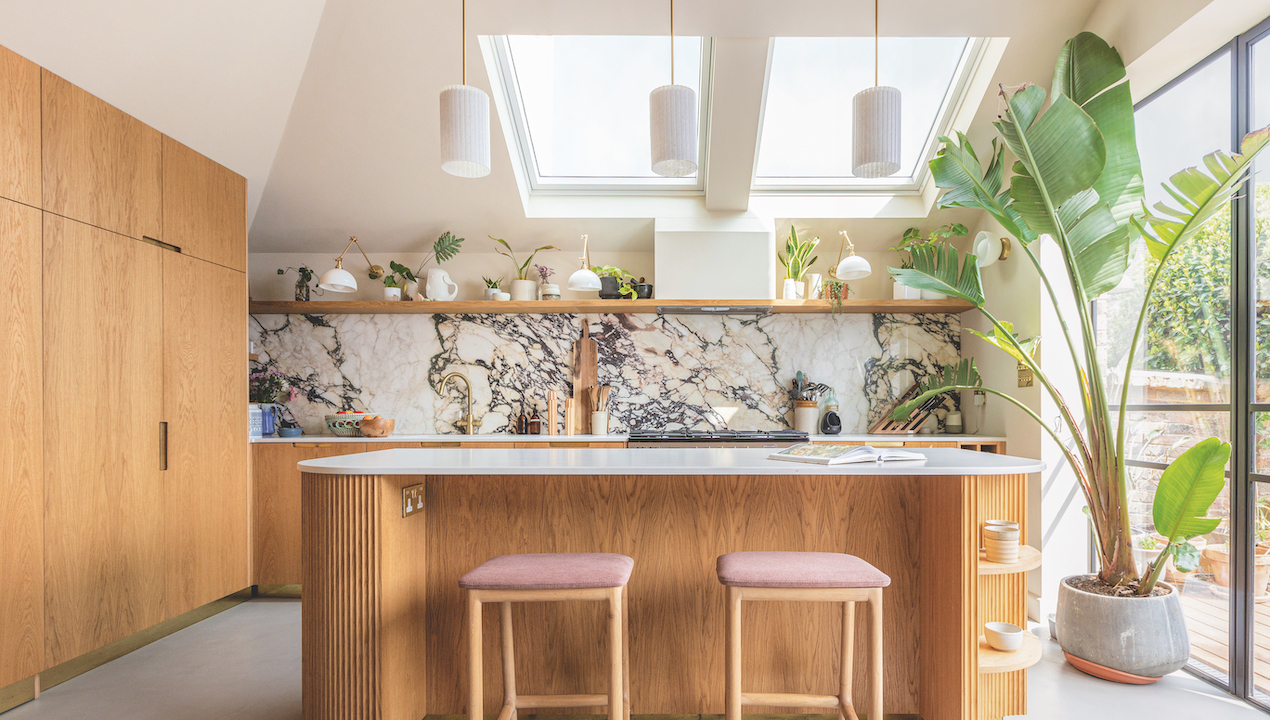

Releasing oxygen and removing carbon dioxide, kitchen plant ideas can help boost the air quality in your space, while edible plants, like basil and parsley, can boost the quality of your meals, too. Bringing the outdoors indoors can also support calmness and harmony in the busiest kitchen.
When you're on the hunt for house plant ideas, any of the best indoor plants are ideal for use in the kitchen, including the air-purifying Boston Fern and mood-boosting Aloe Vera. To inject extra designer styling into your kitchen, try trending houseplants like the fabulous Fiddle Leaf Fig or stripy Snake Plant.
When it comes to showing off your gorgeous kitchen plant ideas, do learn how to clean indoor plant leaves to help them look their best. Also shop around to ensure the pots they are placed in are just as attractive as the plants themselves.
‘Use decorative planters in colours and patterns that add visual interest and complement the plants themselves,’ says Nicolene Mausenbaum, founder of Dezyna. ‘Keep your living décor fresh and dynamic by regularly rotating your individual plants in various groupings to ensure they grow uniformly.’
Kitchen plant ideas
If you are wondering where to put them, how to display them and which houseplant species are best suited to the heat and humidity of a busy kitchen, we’ve dug deep to uncover all the answers to your plant-based questions.
1. Clear the air
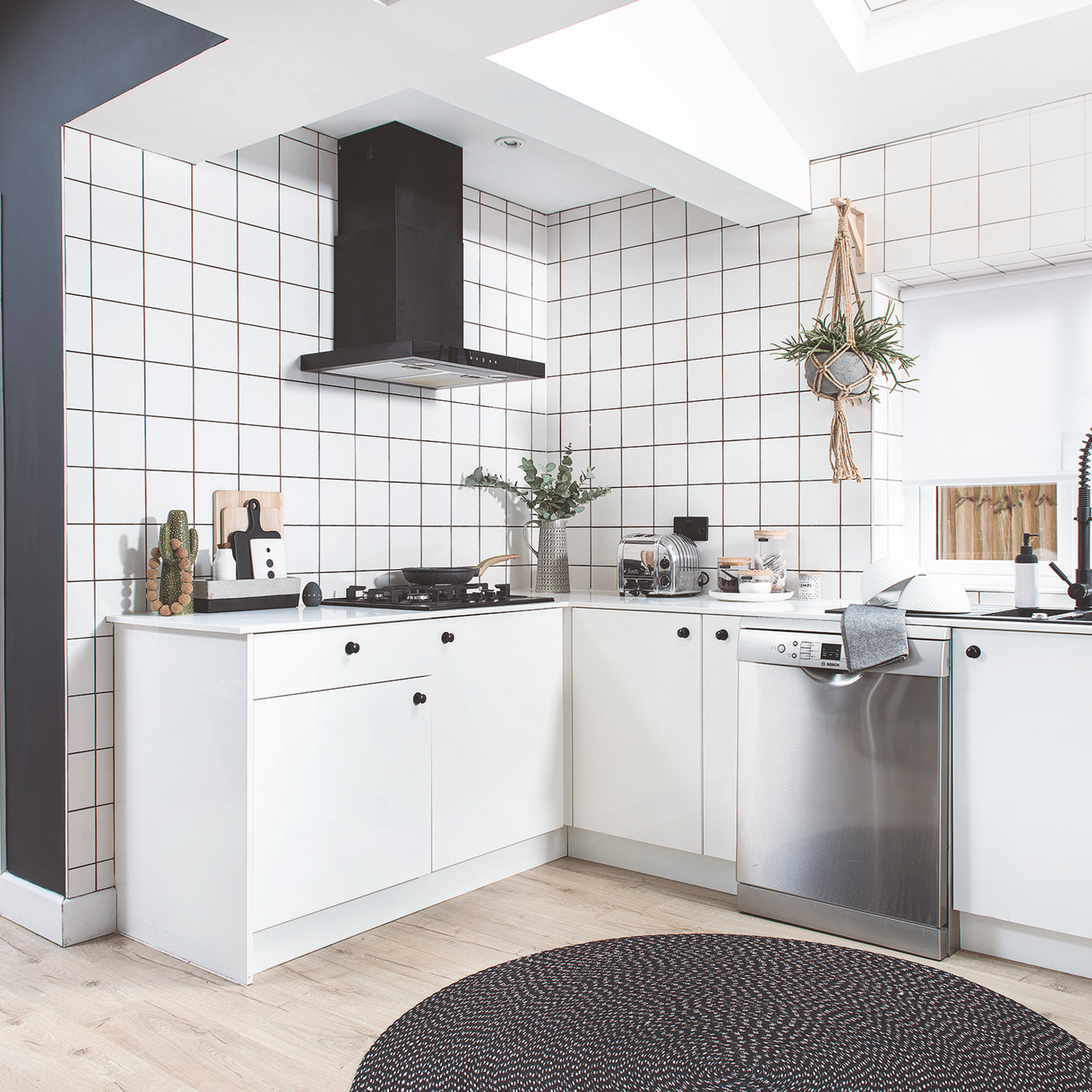
All kitchens need a decent extractor fan but adding in plenty of plant life can also help to clear the air when it’s not in action. ‘Air-purifying plants such as Peace Lilies, help to filter toxins and boost the humidity of a room by up to five per cent,’ says Dani Turner from Bunches.
‘These luscious green plants make the ideal addition to a kitchen – especially in the darker months and are easy to grow and care for,’ she adds. For the best results, use a mix of hanging planters and pots on countertops and shelves around the room to spread out a plant such as this Peace Lily from Crocus's purification powers.
2. Boost your mood
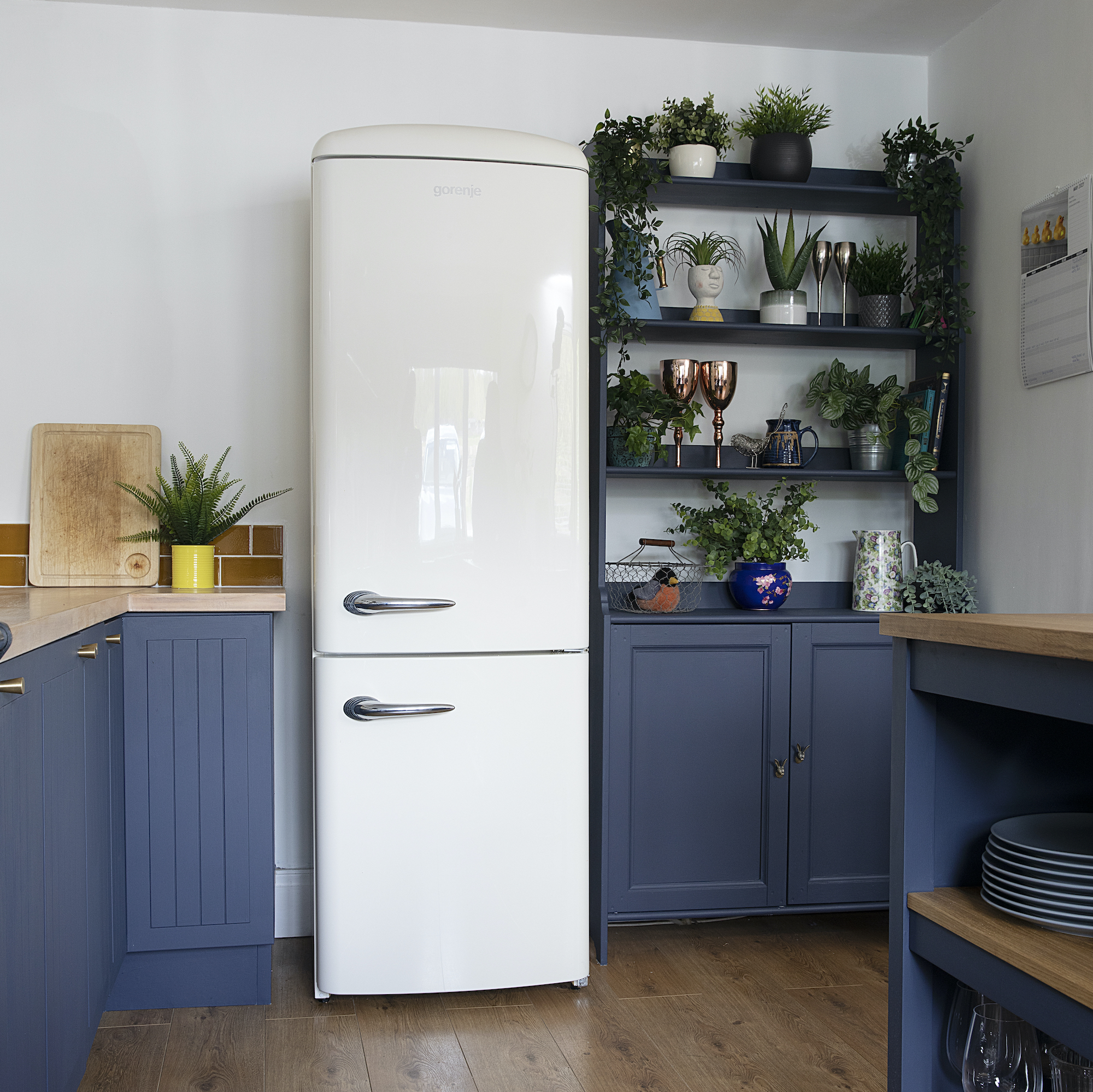
Any houseplant can improve your mood at home, simply because our brains make a connection with nature, and who doesn’t feel happy, recharged and relaxed when surrounded by nature? One solitary houseplant may not cut it. To experience the full mood-boosting powers of houseplants, go for a significant gathering of greenery – especially if your kitchen overlooks an urban jungle, rather than rolling hills.
A inside version of a living wall might not be practical space-wise, but you can achieve a scaled-down version by planting up a countertop shelving unit or dresser. Aloe Vera, Snake Plant and Peace Lily are celebrated mood-boosting houseplants.
‘Scented, flowering plants are also great for boosting your mood due to the gorgeous scents they radiate. Lavender and Jasmine are two of my favourite mood-boosting houseplants, as well as the beautiful Orchid,’ adds Jo Lambell founder of Beards & Daisies.
3. Choose low stress
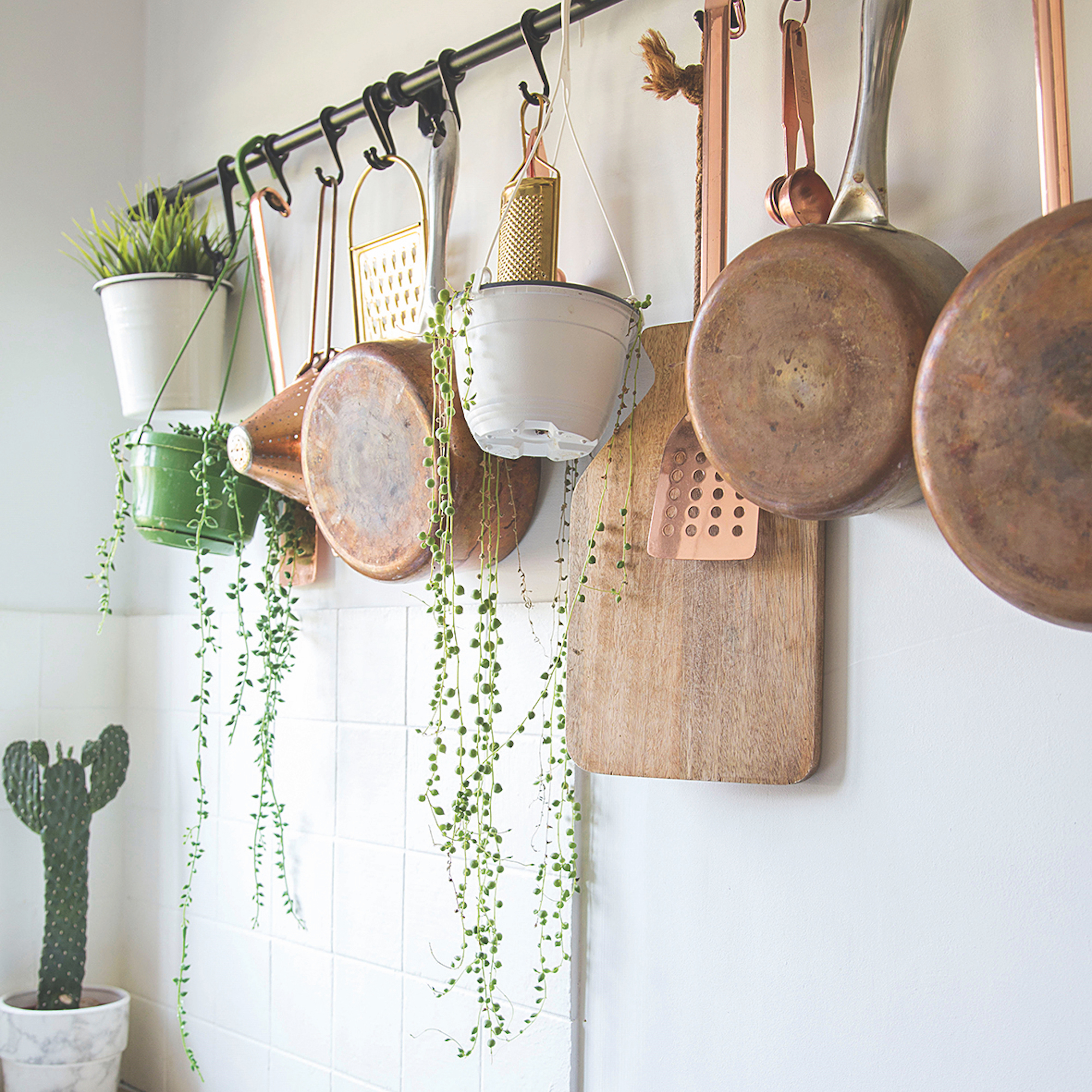
While there’s plenty of research to confirm that a plant-filled home helps to relieve stress, this only applies to healthy, verdant foliage that’s a pleasure to have around. If you’re not naturally green-fingered, the stress of learning how to keep them alive can outweigh the benefits.
The key, says Beards & Daisies' Jo Lambell, is to seek kitchen plant ideas that won’t take over your life. One of our favourite low stress houseplants is String of Pearls (such as this Curio rowleyanus from Crocus), which requires a bright spot and moderate watering to survive and looks so pretty decorating the utensil rail shown here. ‘I’d also recommend the Spider Plant from Beards & Daisies. Not only is it easy to care for but it’s also a great air purifier that will help rid your kitchen of any strong scents, leaving your kitchen feeling fresh.
For a flowering houseplant that will add some colour to your kitchen, Jo suggests the elegant Peace Lily. ‘It’ll absolutely thrive in the high humid environment of your kitchen and won’t be too demanding either,’ she says.
4. Work the windows
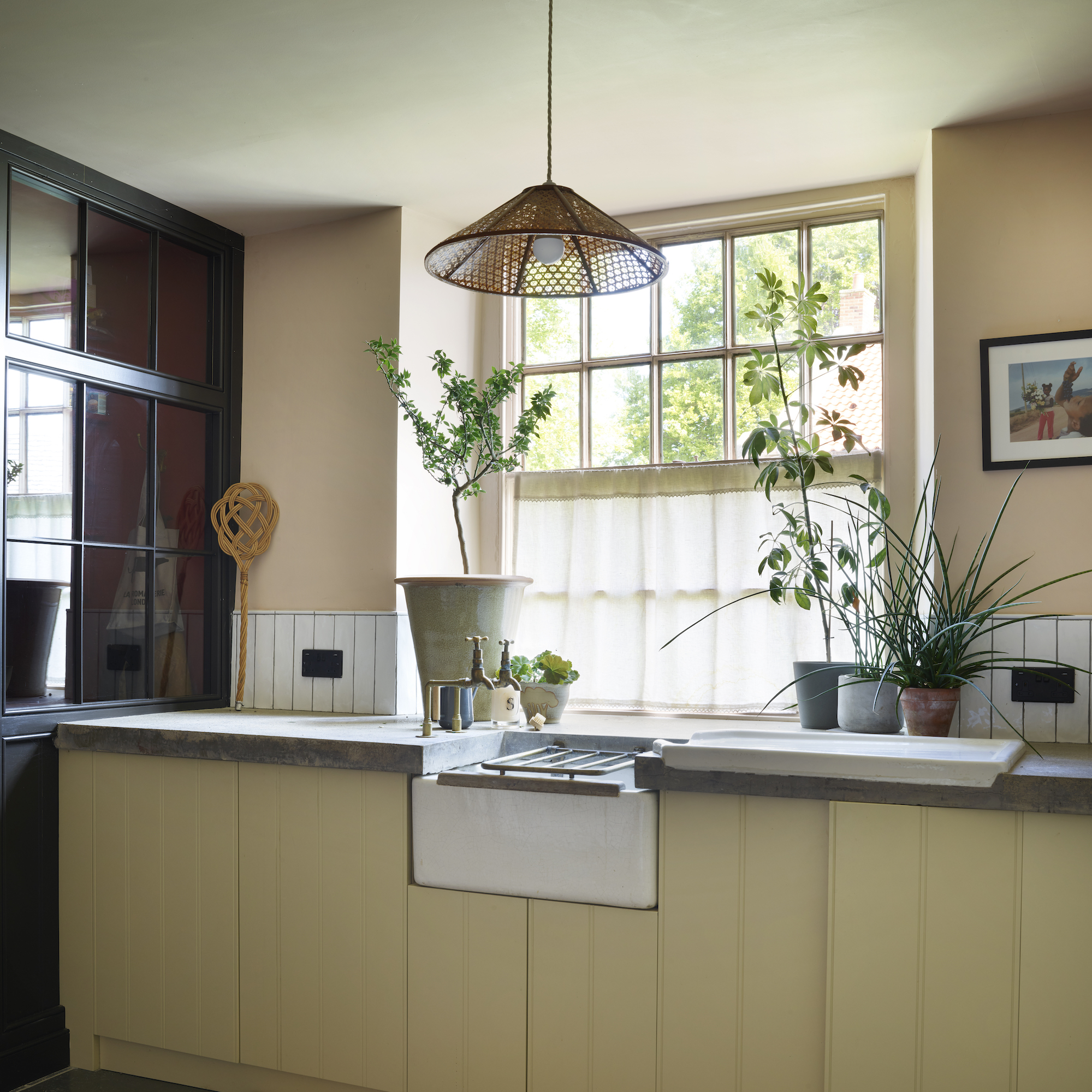
Positioning plants around a window in the kitchen is a great way to bring the outdoors in and can be especially effective if your kitchen overlooks a street or generally lacks a nature-led view. Houseplants with flowing fronds at different heights – use planters with legs to raise foliage up – can also be used to add a little privacy if your kitchen is overlooked.
Plants that thrive in direct sunlight include Aloe Vera like this Medicinal Aloe Vera pot plant from Amazon and pretty much any succulent. ‘Herbs also make a fantastic choice if you’ve got a sunny window spot in the kitchen to fill, adding nature to the space, and gaining delicious fresh herbs to spruce up your meals,’ adds Patty Willems, from sustainable plant pot company, Elho. ‘Basil needs around seven hours of direct sunlight each day, and it’s beautifully aromatic, so that is our go-to!’ Read up on how to grow basil from shop bought and you'll enjoy a bountiful harvest.
5. Perk up dark corners
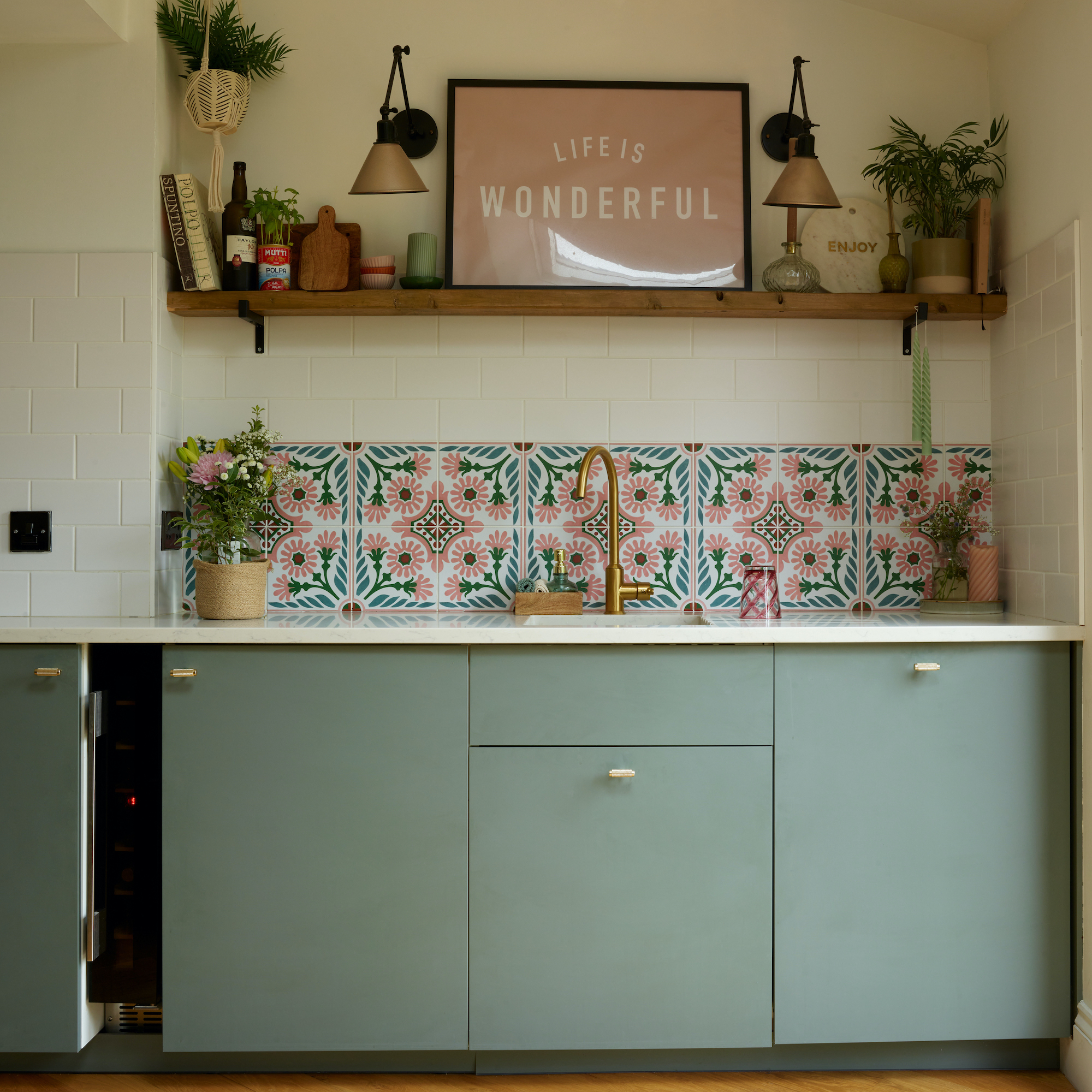
Houseplants are perfect for adding a splash of natural colour to the darker corners of your kitchen. Introduce them on kitchen shelves tucked into niches, the otherwise wasted corner of a worktop and anywhere else that could use a little lift from Mother Nature.
All houseplants need some daylight to thrive but there are good options for areas in your kitchen that only receive indirect light, such as a Boston Fern, Chinese Money Plant and Devil’s Ivy. ‘If you’re a fan of a hanging plant we’d also recommend the Heart Leaf Philodendron, an easy-to-care for plant which won’t mind a little shade,’ adds Jo Lambell, founder of Beards & Daisies.
6. Install a herb trough
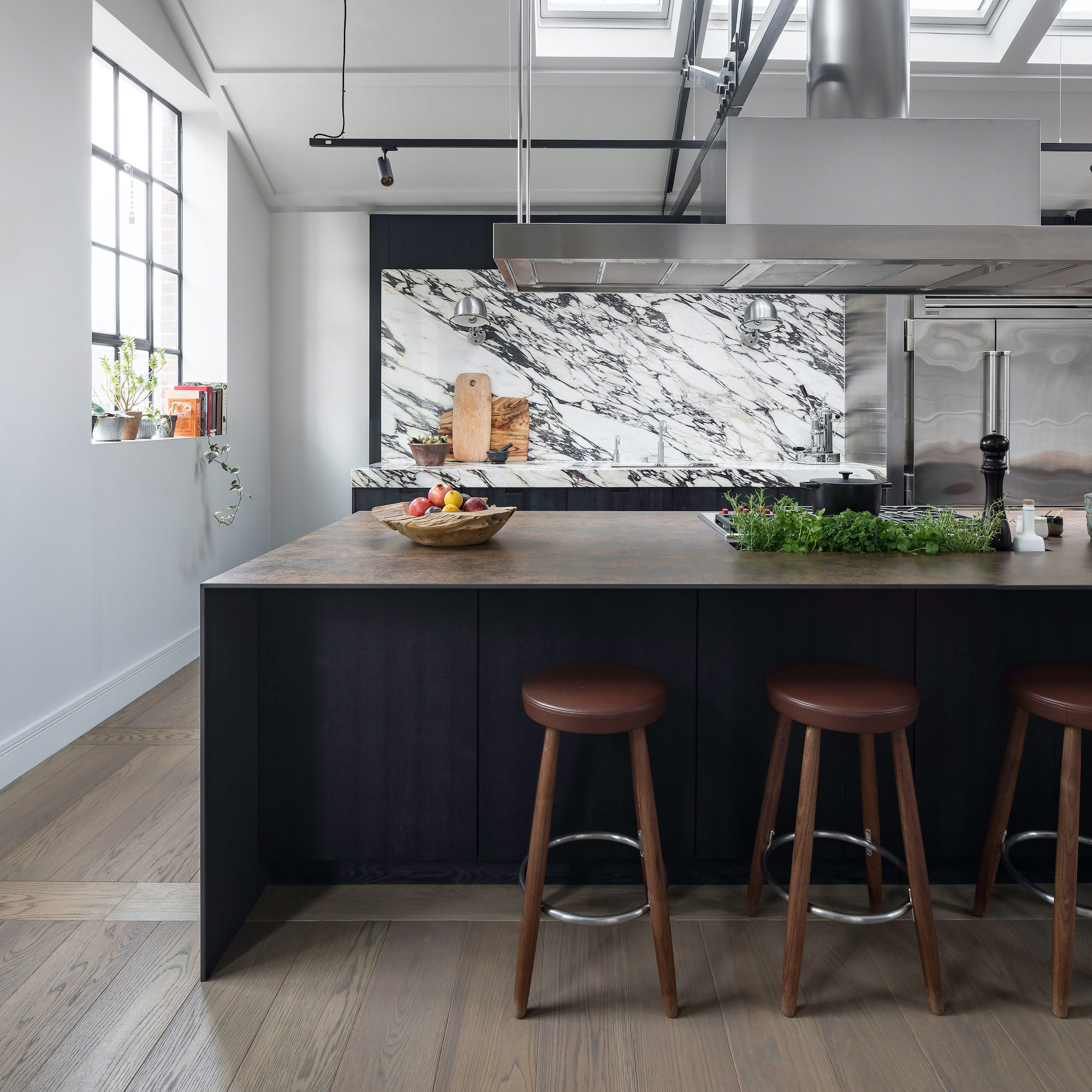
Sure, you can keep fresh herbs in pots on your countertops, but a dedicated built-in herb trough is a far more sophisticated indoor herb garden solution. Traditionally designed for entertaining (filled with ice and bottles of bubbly), Trough Sinks are made from stainless steel, making them rust-free and easy to clean. Plumbed into a drain, any excess water will flow away, which helps prevent herbs becoming waterlogged and dying.
‘Integrating a herb garden into your worktops – on an island or at the back of the prep area – is a great way to keep fresh herbs close to hand when cooking, while making a feature of the greenery,’ says Sam Hart, senior kitchen designer, Roundhouse. Keep your herbs in their original pots so they can be easily relocated to make way for that integrated ice bucket when the kitchen disco is in full swing!
7. Take it up high

Using the wasted space between wall cabinets and ceiling for a houseplant injection is a great way to bring greenery into a small kitchen without taking up precious counter space. Trailing plants will bring the foliage down the sides of your cabinetry but do avoid placing them in front of opening doors!
Look for easy-care plants to reduce the amount of time spent on a step-ladder tending to your lofty plant-scape. Fiona Jenkins, gardening and plants expert at MyJobQuote, recommends the drought tolerant Peperomia such as the Peperomia polybotrya from Crocus, aka radiator plants, which have water-storing leaves and love humid conditions. ‘They don’t mind low and fluorescent light, so you can perch them on kitchen cabinets to make a decorative display,’ she says. ‘Varieties of trailing English ivy such as Hedera helix ‘Pittsburg’ also make good kitchen cabinet plants as they don’t need frequent watering and like a slightly humid environment whether it’s light or shady.’
8. Make a statement
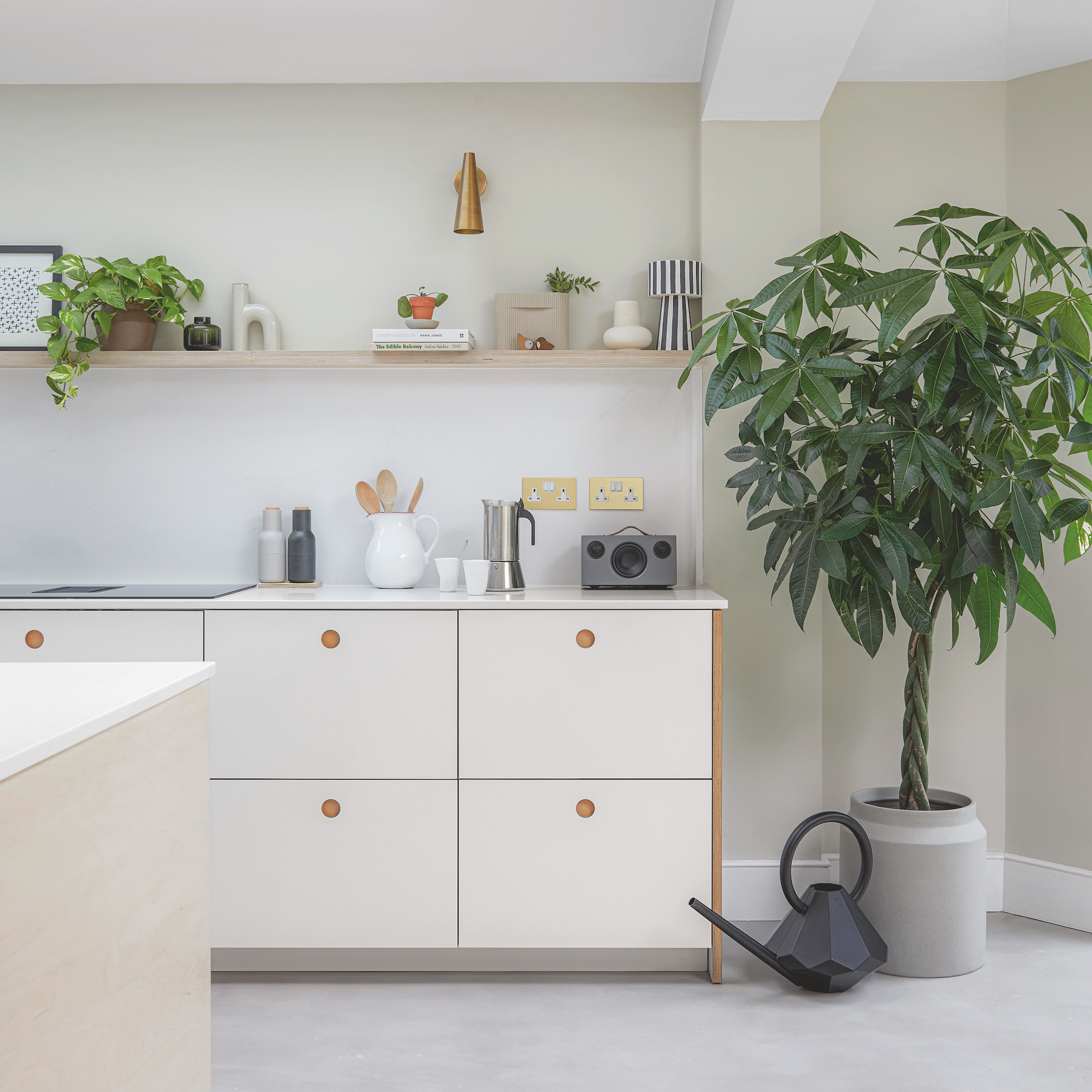
If you have floorspace to spare in your kitchen, an impressive indoor tree such as the Ficus benjamina 'Exotica' from Crocus in a generous planter will add high impact jungle-like greenery. Go for the biggest planter you can accommodate in order to give your plant plenty of room to grow. Positioning under a skylight will also encourage upwards growth.
Monique Kemperman of Thejoyofplants.co.uk, has several suggestions for statement houseplants. ‘Monstera is famous for its large, dramatic, fenestrated leaves. It can grow quite tall and fill up a corner nicely. Provide it with bright, indirect light and some support for climbing if desired,’ she says. ‘I also love a Fiddle Leaf Fig for floor standing pots. They are known for their impressive, large, violin-shaped leaves and can grow tall to create a bold focal point in a kitchen.’
9. Plant up your kitchen shelves
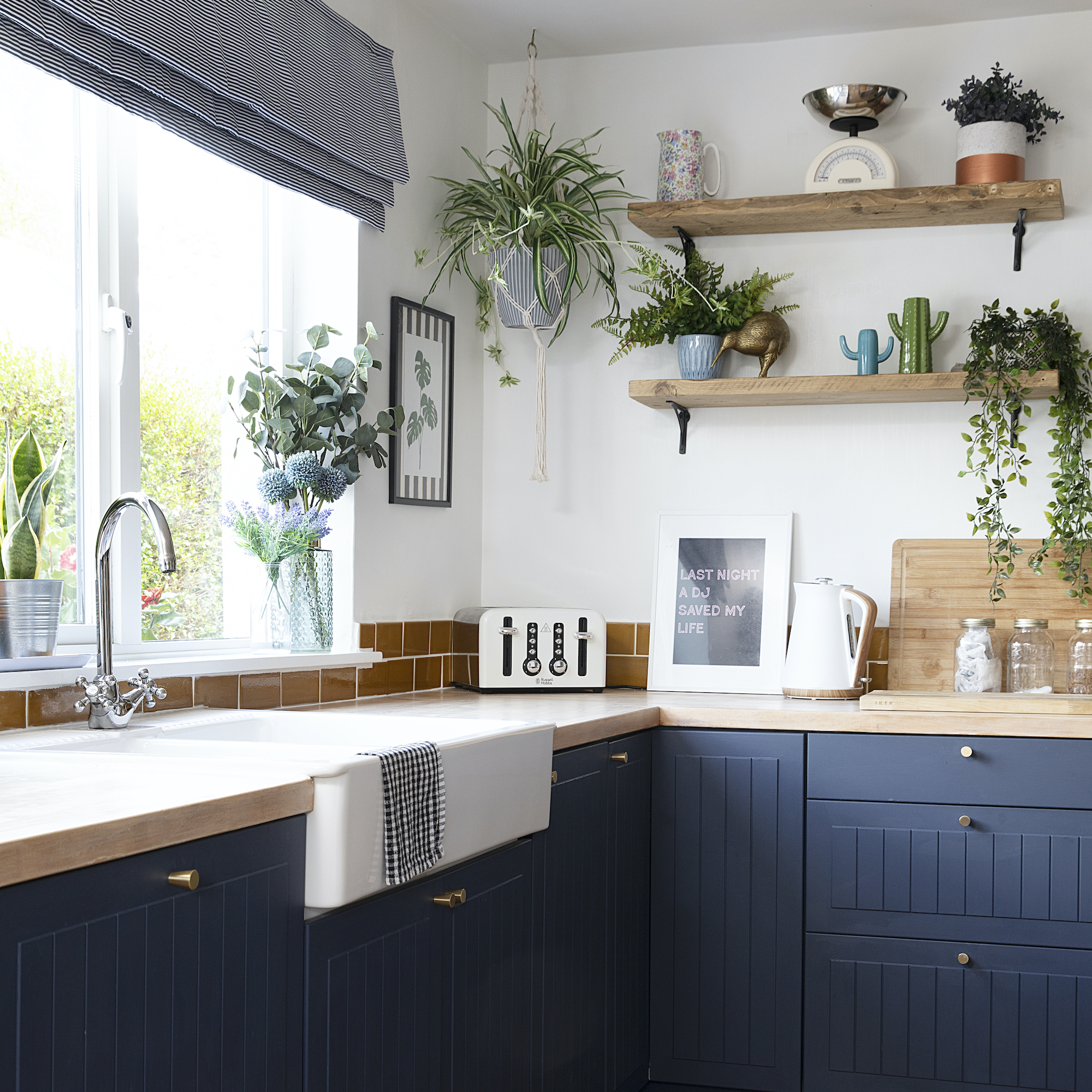
‘No matter the style of your kitchen, creating a vertical focal point by adding plants to wall-mounted shelves as part of your décor display is a lovely way to enhance your cooking space,’ says interior designer Nicolene Mausenbaum, founder of Dezyna.
‘Have fun and experiment by adding dimension to your display by arranging plants of different sizes, shapes, and textures in a stylish composition, ensuring that they receive an adequate amount of light. Be sure to place sun-loving plants on shelves closer to natural light sources than low-light plants,’ adds Nicolene.
10. Choose pretty pots
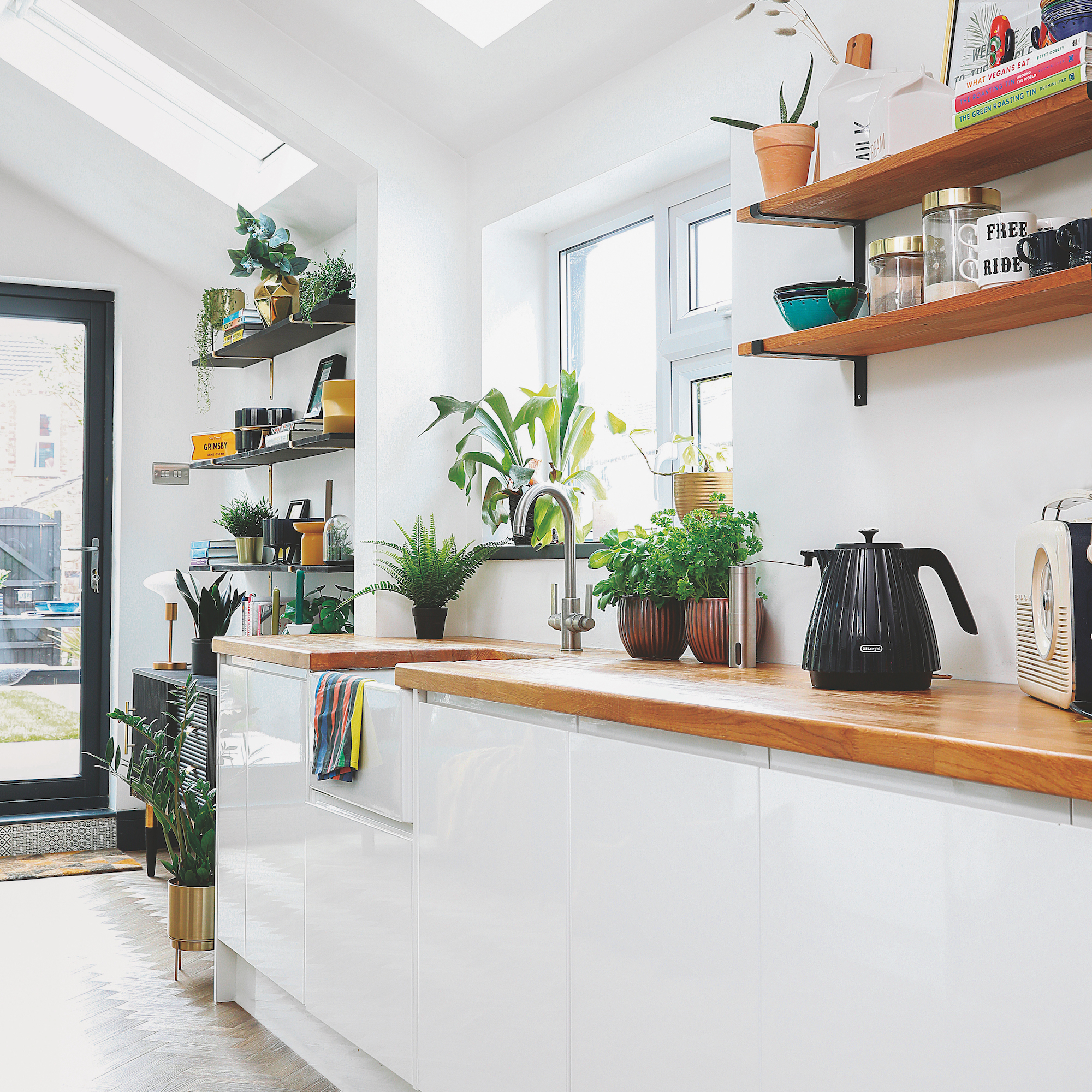
Your choice of planter or pot can also dial up design interest in the kitchen. Look for plant containers in colours and finishes that support those in your kitchen. For example, brass pots and planters will complement brass light fittings, or woven hanging pots can pick up the texture of a sisal rug.
‘When selecting a pot for your plant, it’s important to consider the size of the grower’s pot it came in. If the grower’s pot is less than 15cm in diameter, choose an indoor pot that is at least 1cm larger in diameter to allow your plant to grow and prevent it from becoming root-bound too quickly. If the grower’s pot is over 16cm in diameter, choose an indoor pot that is at least 2cm larger in diameter,’ adds Tom Cook, Houseplant Buyer at British Garden Centres.
FAQs
What plant is good for a kitchen?
When pondering kitchen plant ideas, the light levels in your kitchen should steer your choices in the first instance. A plant that favours bright, direct sunlight will not fare well in a gloomy north-facing kitchen. Also think about heat. A typically hot kitchen, for example south-facing with lots of glazing, is better suited to plants that can handle arid conditions.
Care and maintenance requirements should also be reviewed before you buy, as each plant will come with different levels of neediness! English Ivy is a solid choice for kitchens as it can help purify the air (but it is poisonous to pets so avoid if you have four-legged friends in residence), Spider plant is great for houseplant serial killers, it’s almost impossible to kill, and a Begonia can be used to add colour and pattern (and grow well in humid conditions).
Aloe vera can be handy to have nearby for treating minor burns. Slice off a leaf near the stalk and cut open lengthways to access the gel inside, which can be rubbed directly onto the affected area with cooling results. And let’s not forget herbs. Basil, rosemary and coriander are amongst the easier herbs to grow indoors and so much better than using dried herbs in cooking.
How can I decorate my kitchen with plants?
While it’s perfectly acceptable to fill every surface of your kitchen with houseplants, you may soon discover the upkeep and space sacrifices outweigh the benefits of being surrounded by greenery. When decorating your kitchen with plants, it pays to build up your collection slowly, perhaps by gathering three or five pots on a shelf or corner spot on the kitchen worktops.
See how well you get on with keeping them alive, and then expand your collection to other areas. Top decorative spots for houseplants in the kitchen include hanging planters from the ceiling to make good use of vertical storage, using larger floor-standing pots to elevate empty corners and dressing glass dressers with trailing foliage and hardy succulents. Plus, you can use home decor discount codes to find all the pots and containers you'll need, while saving your pennies for the plants themselves.
Whether you're introducing a handy herb garden for on-hand ingredients or a lush jungle as a style statement, it's time to get green-fingered in the kitchen.
Get the Ideal Home Newsletter
Sign up to our newsletter for style and decor inspiration, house makeovers, project advice and more.

Linda Clayton is a professionally trained journalist, and has specialised in product design, interiors and fitness for more than two decades. Linda has written for a wide range of publications, from the Daily Telegraph and Guardian to Homes & Gardens and Livingetc. She has been freelancing for Ideal Home Magazine since 2008, covering design trends, home makeovers, product reviews and much more.
-
 Should your front door colour match your hallway? Interior experts reveal 3 reasons why it should (and 3 reasons it shouldn't)
Should your front door colour match your hallway? Interior experts reveal 3 reasons why it should (and 3 reasons it shouldn't)Are you team matching or contrasting?
By Ellis Cochrane
-
 This £200 limited-time discount makes this Dyson vacuum cheaper than I’ve ever seen it - run don’t walk to Argos for this bargain
This £200 limited-time discount makes this Dyson vacuum cheaper than I’ve ever seen it - run don’t walk to Argos for this bargainIt's the most affordable Dyson on the market right now
By Lauren Bradbury
-
 Martin and Shirlie Kemp’s pastel flower beds has given their Victorian renovation a romantic look - how you can get the look
Martin and Shirlie Kemp’s pastel flower beds has given their Victorian renovation a romantic look - how you can get the lookTheir pastel garden is the cottage garden inspo you've been looking for
By Kezia Reynolds